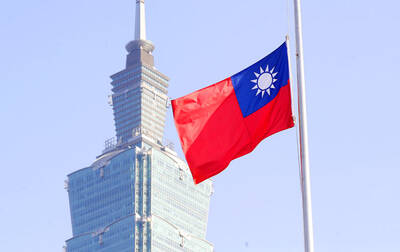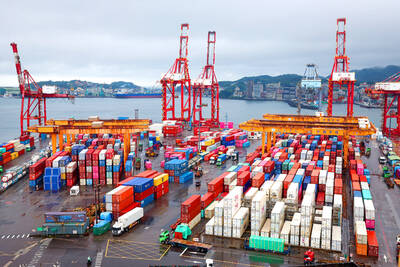CPC Corp, Taiwan (台灣中油), the nation’s state-owned oil refiner, will utilize less of its capacity to turn crude into fuels next year on expectations demand may fall further.
The refiner expects to process about 587,000 barrels of crude oil a day next year, or 81.5 percent of its capacity, compared with an estimated 83.8 percent this year, according to the government’s draft budget for next year received by lawmakers.
Taiwanese fuel demand has declined as the economy grew at the slowest pace in more than a year in the second quarter. Losses from selling gasoline, liquefied petroleum gas and fuel oil are prompting CPC to utilize less of its refining capacity, the company’s vice president Chu Shao-hua (朱少華) said yesterday.
“We’re losing money in our refining business,” Chu said by telephone in Taipei, where the company is based. “We’re relying on petrochemicals, as well as exploration and production to make up for the losses.”
CPC forecasts net income for next year to fall 13 percent to NT$5.09 billion (US$161 million), according to the government budget.
Crude oil imports will drop next year as processing rates decrease, Chu said, declining to give details. CPC has three refineries with a combined processing capacity of 720,000 barrels a day, and an ethylene output capacity of 1.08 million tonnes a year. Ethylene, made from naphtha, is a key ingredient in plastics and synthetic fibers.
Taiwan’s consumption of petroleum products fell 4.1 percent from a year earlier in June, the Bureau of Energy said last month. GDP rose 4.32 percent from a year ago in the April-to-June period, the slowest pace since expanding 4.19 percent in the first quarter of last year, the statistics bureau said on Aug. 22.
Production of fuel oil is expected to decline 9.4 percent from this year’s estimate to 6.68 million kiloliters (about 42 million barrels). Gasoline output will rise 1.9 percent to 8.88 million kiloliters next year, while diesel production will increase 2.7 percent to 7.08 million kiloliters, according to the government’s draft budget.
Output of petrochemicals will climb 5.8 percent to 4.19 million tonnes next year.
The refiner has investments in oil and gas fields in Africa, Southeast Asia, the US, Australia and Latin America. In the Taiwan Strait, CPC is developing a field with natural gas reserves of around 6 billion cubic meters, the company said in January 2005. Output is scheduled to start in 2010.

ELECTRONICS BOOST: A predicted surge in exports would likely be driven by ICT products, exports of which have soared 84.7 percent from a year earlier, DBS said DBS Bank Ltd (星展銀行) yesterday raised its GDP growth forecast for Taiwan this year to 4 percent from 3 percent, citing robust demand for artificial intelligence (AI)-related exports and accelerated shipment activity, which are expected to offset potential headwinds from US tariffs. “Our GDP growth forecast for 2025 is revised up to 4 percent from 3 percent to reflect front-loaded exports and strong AI demand,” Singapore-based DBS senior economist Ma Tieying (馬鐵英) said in an online briefing. Taiwan’s second-quarter performance beat expectations, with GDP growth likely surpassing 5 percent, driven by a 34.1 percent year-on-year increase in exports, Ma said, citing government

‘REMARKABLE SHOWING’: The economy likely grew 5 percent in the first half of the year, although it would likely taper off significantly, TIER economist Gordon Sun said The Taiwan Institute of Economic Research (TIER) yesterday raised Taiwan’s GDP growth forecast for this year to 3.02 percent, citing robust export-driven expansion in the first half that is likely to give way to a notable slowdown later in the year as the front-loading of global shipments fades. The revised projection marks an upward adjustment of 0.11 percentage points from April’s estimate, driven by a surge in exports and corporate inventory buildup ahead of possible US tariff hikes, TIER economist Gordon Sun (孫明德) told a news conference in Taipei. Taiwan’s economy likely grew more than 5 percent in the first six months

SMART MANUFACTURING: The company aims to have its production close to the market end, but attracting investment is still a challenge, the firm’s president said Delta Electronics Inc (台達電) yesterday said its long-term global production plan would stay unchanged amid geopolitical and tariff policy uncertainties, citing its diversified global deployment. With operations in Taiwan, Thailand, China, India, Europe and the US, Delta follows a “produce at the market end” strategy and bases its production on customer demand, with major site plans unchanged, Delta president Simon Chang (張訓海) said on the sidelines of a company event yesterday. Thailand would remain Delta’s second headquarters, as stated in its first-quarter earnings conference, with its plant there adopting a full smart manufacturing system, Chang said. Thailand is the firm’s second-largest overseas

SUPPLY RESILIENCE: The extra expense would be worth it, as the US firm is diversifying chip sourcing to avert disruptions similar to the one during the pandemic, the CEO said Advanced Micro Devices Inc (AMD) chief executive officer Lisa Su (蘇姿丰) on Wednesday said that the chips her company gets from supplier Taiwan Semiconductor Manufacturing Co (TSMC, 台積電) would cost more when they are produced in TSMC’s Arizona facilities. Compared with similar parts from factories in Taiwan, the US chips would be “more than 5 percent, but less than 20 percent” in terms of higher costs, she said at an artificial intelligence (AI) event in Washington. AMD expects its first chips from TSMC’s Arizona facilities by the end of the year, Su said. The extra expense is worth it, because the company is